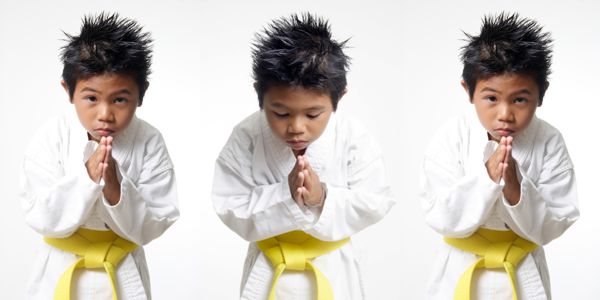Martial arts can help kids learn more about discipline, respect, concentration and empathy. Learn if it is right for your child.
All parents want their children to grow up healthy and develop discipline, focus and respect. Introducing them to martial arts is one way to help kids reach those goals.
Martial arts requires strength, coordination and mental discipline. This sport can help your child learn:
- Concentration
- Social skills
- Personal safety
- Confidence
- Ways to handle daily challenges
Training requires self-control, honesty and concern for the well-being of others. Because of this, many martial arts instructors ask students to improve themselves first and see these achievements as personal victories. In turn, these small wins can foster a sense of empathy for others as they strive for personal goals.
You can start your child in martial arts training as young as age 4, although starting between ages 5 and 10 is more common. If kids can show interest, pay attention, follow directions and mimic sequences of movements, then they are probably ready. But you may want to ask your doctor first if your child is ready for this activity.
Self-defense training is often a part of martial arts. This may be especially helpful to girls who can use their natural strengths, such as power in the legs, against larger opponents. This training can help raise your child’s confidence.
Health Benefits
Martial arts training is year-round. The health benefits and improvements in technique can be steady. Kids are often grouped for competition based on age, gender, size and skill level, which reduces injury risks.
Participants improve in each form of martial arts by developing their core muscles in the torso. Overuse injuries are rare. Development of these core muscles helps to bring speed and fine motor skills to the arms and legs.
Martial arts can result in improved:
- Muscle tone
- Appearance
- Strength
- Stamina
- Heart health
- Flexibility
- Agility
- Reflexes
- Stress responses
- Balance
- Posture
Safety Concerns
Though martial arts can be a safe sport with proper guidance, care must be taken to keep a child safe and injury-free. These are some of the more common injuries that can occur with the martial arts:
- Neck and spine injuries, usually as the result of a kick or a fall.
- Eye injuries.These are more common than in other sports where eye protection is worn.
- Head injuries, usually from a blow to the head. This can be anything from a lump to a concussion.
- Injuries to the shoulders and arms, most commonly from a fall or blow to the arm.
- Sprains and other injuries to the foot or ankle. These can occur with kicking or with assuming certain body positions.
Martial Arts Styles
Though most martial arts have origins in Asia, there are many different styles. Yet each form emphasizes a connection between mind and body.
Six of the better known martial arts styles include:
Tae kwon do, which means “way of the foot,” is the national sport of Korea and the world’s most popular martial art. It emphasizes:
- Hand and footwork (especially high kicks)
- Keeping opponents at a distance
- Splitting wood and bricks with bare hands and feet
- Movement patterns called forms
- Sparring
Jujitsu is Japanese in origin and means the “compliant art.” It emphasizes moderation in everything and features a lot of sparring and weapons training.
Aikido is also Japanese and means “way of harmony.” It focuses on keeping calm during stressful situations or when resolving conflicts. It teaches how to disable an attacker without causing serious injury.
Judo means “gentle way.” This form of jujitsu, developed in Japan, has lots of wrestling-type moves. It stresses moral and mental progress and focuses on competition.
Karate accents defensive moves with punching, blocking, throwing and kicking. This Japanese form means “empty hand,” but may also include using weapons.
Kung fu means “well done” and represents many fighting arts. Coming from China, kung fu includes sharp blows and kicks to pressure points on an opponent’s body.
Once you know the type of martial arts you’d like your child to enjoy, find the right school. Think about pricing, instructors and facilities. Different schools may emphasize different values, so take the time to find out which school matches your family’s ethics.
By Howard Seidman, Contributing Writer, myOptumHealth











